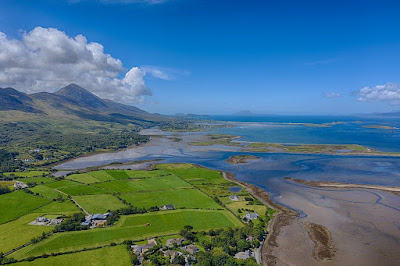 |
Modern representation of Grace O’Malley. (Makerva/Deviant Art)
Clew Bay was home to Rockfleet Castle, the stronghold of Grace O’Malley, or Granuaile as she was known. O’Malley was the leader of a clan of pirates that controlled the Irish coastline through violence and intimidation. She had hundreds of men and over twenty ships under her command, raiding rival clans and merchant ships at will.
Eventually, government officials
had had enough and in 1574 a fleet was sent to raid O’Malley’s castle. She and
her men turned the fleet away in a violent counterattack which caused the
government ships to retreat. However, she was captured and imprisoned in 1577
but was soon out and plundering again.
Gráinne Ní Mháille
Grace O’Malley (Gráinne Ní Mháille) was born
in Ireland around 1530 as a daughter of the wealthy nobleman and sea
trader, Dubhdara O'Malley, who commanded the biggest fleet of ships
in Ireland. For hundreds of years, the O’Malleys had been sailing their
ships around the coasts of Ireland, Scotland and northern Spain, trading, fishing,
and plundering.
 |
| Clew Bay (c) By Mariusz Z - flickr.com, CC BY-SA 2.0 |
Queen Elizabeth used the feuding
between Irish chieftains to her advantage, replacing Chieftains with those who
promised to be loyal to her and adopt English law.
Sir Richard Bingham
At the age of fifty-six, Grace
O’Malley was finally captured by Sir Richard Bingham (1528 – 1599), a ruthless
governor that was appointed to rule over Irish territories. She closely escaped
the death sentence, but over the course of time her influence, wealth, and
lands faded, until she was on the brink of poverty.
She wrote to Queen Elizabeth
explaining her plight. She asked the queen to give her “free liberty
during her life to invade with fire and sword all your highness’ enemies
without any interruption of any person whatsoever.” In the guise of fighting
for the queen, she could continue her life at sea, unhindered by the English
and free from Bingham’s control.
 |
‘The meeting of Grace O'Malley and Queen Elizabeth I.’ (Public Domain)
Historic Meeting
Her situation took a turn for the
worst when her dearest son, Tibbot na Long (‘Toby of the Ships’), was captured
by Bingham and was facing execution. In September 1593, O’Malley secured an historic
meeting with Queen Elizabeth I, the woman against whom she had rebelled
and in whose hands her life and her son’s life now lay. The meeting took place at
Greenwich Castle. Their conversation was conducted in English, as Grace spoke
no Latin and Elizabeth spoke no Irish.
 |
| Sir Richard Bingham from Wikipedia |
Grace explained to the queen that her actions were merely to protect her family and her people. The queen listened with admiration and pity as Grace told her story and how she suffered at the hands of the English, and particularly Sir Richard Bingham. In this amazing meeting of two powerful women, Grace managed to convince the queen to free her family and restore much of her lands and influence.
Decline and Death
However, growing political unrest
and turmoil in Ireland, culminated in the demise of the old Gaelic way of life and
the end of the world of clans and chieftains. By this time, Grace was old and
weary. She lived out her last years in the comfort of her fortress at Rockfleet
Castle where she died around 1603.
 |
Rockfleet Castle. (Mikeoem/CC BY SA 4.0)
Grace O'Malley is not mentioned
in the Irish annals, so documentary evidence for her life comes mostly
from English sources. As a pirate, she was largely written out of Irish
history, so limited information exists of her life. She successfully defended
the independence of her territories at a time when much of Ireland fell under
the English rule and is still considered today ‘the pirate queen of Ireland.’ Her
story lives on in the many folk stories, songs, poems, and musicals which
help to preserve the legend of the Pirate Queen.





